Alaskan Husky
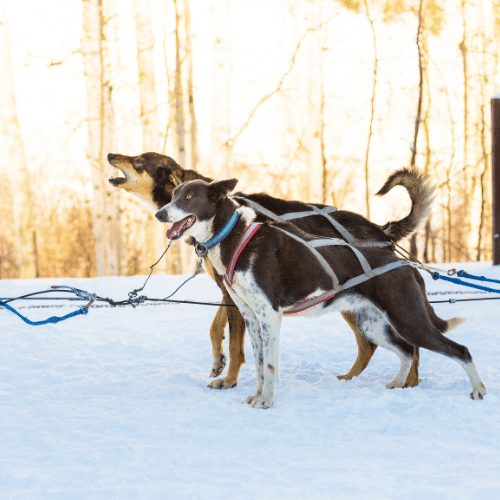
The Alaskan Husky is the brother of the Siberian Husky. While currently not recognized by the AKC, this “unofficial” breed is a mix of several working dogs.
Siberian Huskies are crossed with high-endurance and high-speed breeds in order to produce superior sled dogs. Breeds used to create the Alaskan Huskies are for example:
Their looks can vary drastically based on the exact mix of every single dog. Short-coated or long-coated, in a variety of colors, this type of Husky does not have any specific breed standard.
Alaskan Huskies are not good pet dogs. They are fantastic companions if you are looking for a dog to go running or backpacking with.
In families who do not participate in active hobbies though, these dogs become highly destructive and problematic. They are true athletes and will require an athlete's exercise regime!
Back to top of pageAlaskan Malamute
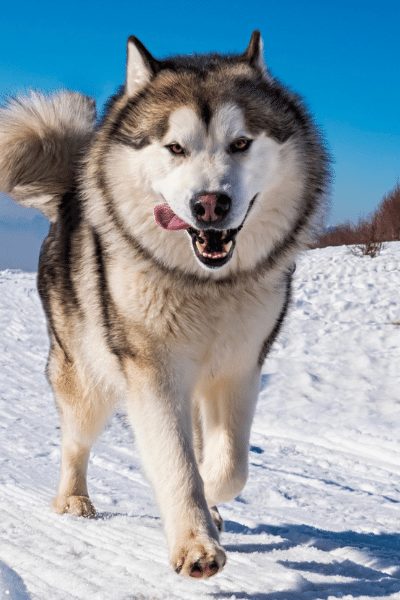
The Alaskan Malamute is the big cousin of the Siberian Husky. While looking very similar, these dogs are a lot larger. Males can reach up to 95 pounds in size and stand as tall as 26 inches.
Alaskan Malamutes are one of the oldest sled dog breeds. They descended directly from wolves and were creates as long as 2000-3000 years ago. Their name “Malamute” is derived from the tribe that originally created this breed: the Mahlemut.
Malamutes were used for any kind of task that came up: hunting game, towing supplies, guarding properties, and providing warmth to their owners. They were (and are) very “wolf-like” dogs. It is said that the Mahlemuts would tie females in season up to trees in the forest so that wild wolves would mate with them, increasing the wolf percentage in their blood.
In 1935 the American Kennel Club accepted the Malamute as a registered breed. Nowadays, they are rarely used in their original functions anymore. They do retrain a strong independent character from their wolf heritage. This trait is passed on when this dog is crossed with other breeds as well, such as in creating the King Shepherd.
This type of Husky is not a good choice for first-time dog owners. You need plenty of space and experience to raise and care for a Malamute properly.
Back to top of pageAlaskan Klee Kai
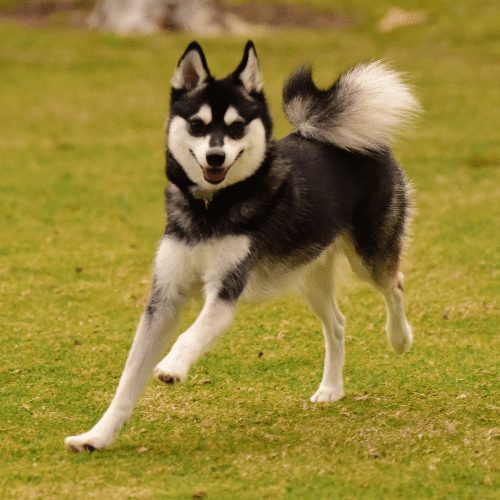
The Alaskan Malamute is a giant Husky, the Klee Klai is a tiny type of Husky!
Similar to many other Husky types, the origin of this breed is in Alaska. Klee Kais once were larger than they are nowadays and assisted their owners in many areas. Pulling sleds, guarding the property and tracking game were just some of their tasks.
In the 1970s, a breeding program in the USA started to selectively pair smaller and lighter Husky-type dogs. The goal was to create a companion dog that looks like a Husky, but is little and has more manageable exercise needs.
The Alaskan Klee Kai indeed is a small dog - weighing only 15-22 pounds and standing at 15-17 inches tall. These dogs are great dogs for owners who want to own a Husky-type dog but are unsure if they can keep up with the exercise needs of a Siberian Husky.
Though tiny, these dogs are athletic and smart. They excel at dog sports such as agility or nosework.
Back to top of pageAmerican Eskimo Dog (Standard)
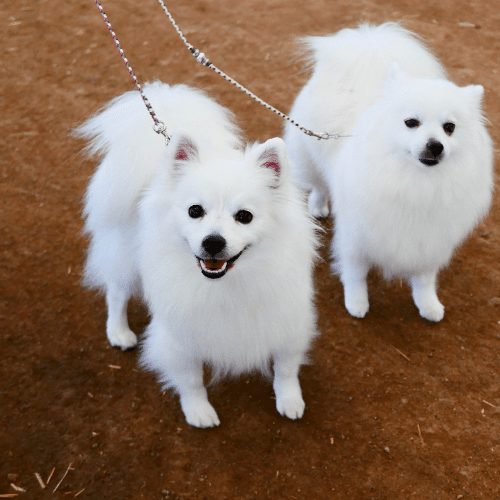
Another small dog on our list, the American Eskimo is the most popular type of Husky companion dog.
Not to be confused with the Klee Klai, American Eskimos are always pure white and do not have any black markings. They also are a bit larger - the Standard-sized dogs weigh 18-35 pounds and stand at 15-20 inches tall.
American Eskimos originated in Germany and became popular as smart and friendly companion dogs all over the world. They are highly intelligent and attach themselves closely to their person.
For dog owners who are looking for an even smaller Husky-type dog, there is also the Miniature and Toy version of the American Eskimo:
Back to top of pageAmerican Eskimo Dog (Mini & Toy)
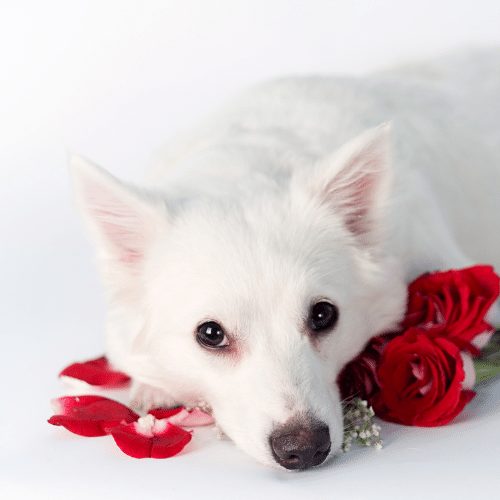
As with many dog breeds (such as also Poodles, Goldendoodles or Schnauzers), the American Eskimo comes in different size categories.
After the original American Eskimo was developed, some breeders kept pairing smaller and smaller dogs. The result was the Miniature and the Toy American Eskimo Dog. These teeny tiny Huskies can be as small as 12-15 inches (Mini) or 9-12 inches (Toy).
They are very friendly dogs with lower exercise needs than most other kinds of Husky. This makes them especially popular as dogs for apartment dwellers and big cities.
Mini and Toy American Eskimos are very intelligent and love to learn tricks. They will happily train with you every day. Due to their small size, they shed much less than full-size Huskies.
Back to top of pageSiberian Husky
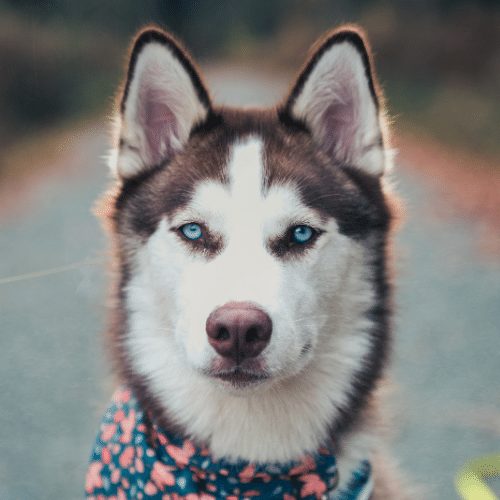
This is the “original Husky”. Siberian Huskies were once bred to be sled dogs. They have phenomenal endurance and are true athletes. While Huskies are mostly known for performing in sled races, they actually worked for the US Army's Arctic Search and Rescue Unit during World War II as well!
Siberian Huskies are medium-sized dogs that grow up to be about 35-55 pounds and 20-24 inches tall. They require extensive amounts of physical exercise and mental stimulation in order to not be destructive. Many owners are surprised by how much their Huskies shed. If acquiring a Husky, get ready for brushing him and providing physical activities daily.
Huskies are very friendly, outgoing and vocal dogs. As long as they are treated well, they are docile and unlikely to bite. They are not the best dog for first-time dog owners due to their extensive needs for stimulation and activity.
Back to top of pageSamoyed
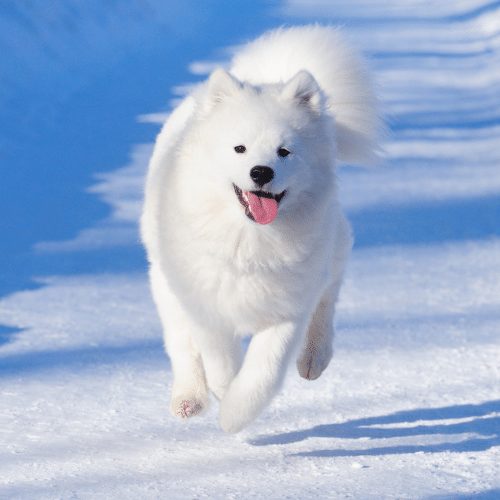
The Samoyed may look like a white Husky, but he is a different breed altogether. These medium-sized dogs are about 21 inches tall and weight 34-55 pounds.
They originally come from Asia and Siberia. The ancestors of the modern-day Samoyed were once used to hunt reindeer. Later on, they served as a herding dog for domesticated herds of reindeer and as sled dogs.
Like all types of Huskies, Samoyeds are very friendly and happy dogs. Due to their extremely thick coat they do not do well in hot climates and cannot be left outside in the summer.
Samoyeds usually have black noses and brown eyes - one way to distinguish them from white Siberian Huskies. While blue eyes may occur occasionally, they are not allowed in the show ring.
Back to top of pageGreenland Dog
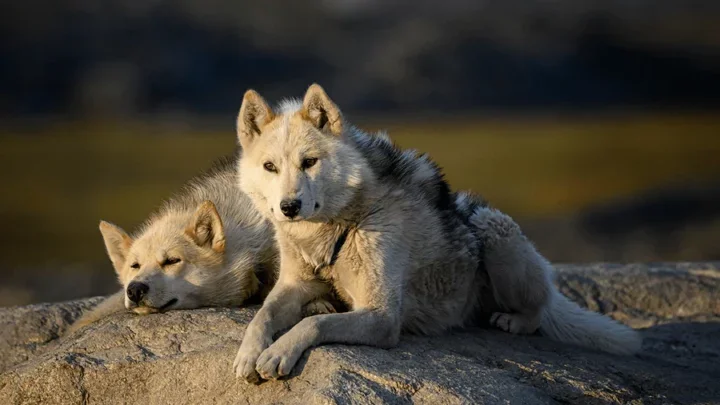
The Greenland Dog was brought from Siberia to North America by the Thule people 1,000 years ago, along with the Canadian Eskimo Dog that is genetically identical.
The first dogs arrived in the Americas 12,000 years ago, however people and their dogs did not settle in the Arctic until the Paleo-Eskimo people 4,500 years ago and then the Thule people 1,000 years ago, both originating from Siberia. Dogs first appeared in Greenland around 4,000 years ago. The Inuit dogs from Canada (Canadian Eskimo Dog) and Greenland (Greenland Dog) descended from dogs associated with Thule people, who relied on them for transportation from Siberia. In 2015, a study using a number of genetic markers indicated that these were both the same dog and should not be treated as separate breeds, that they maintain an indigenous heritage that predates colonization and the timing corresponds with the arrival of the Thule people, and that they were distinct from Siberian Huskies, Alaskan Huskies and Malamutes.
The Greenland Dog is a powerful, heavy-built dog. It has a broad, wedge-shaped head, slightly tilted eyes and small, triangular ears covered with thick fur that prevents frostbite. It has strong, muscular, short-haired legs. The tail is usually rolled along/across its back. When it lies down and curls up to rest, the tail often covers the nose. Its coat is of medium length and consists of two layers. The inner layer consists of short wool-like fur, the outer layer of longer, coarser, water-repellent fur.
A characteristic of most Greenland Dogs is the “úlo”, a triangular shaped area on the shoulders. It is named after a common woman's-knife from Greenland which is of the same shape.
Males are significantly larger than females at between 58 and 68 cm (23-27 in) at the withers; females are between 51 and 61 cm (20-24 in).
Puppies in Greenland run free until they reach adulthood. They are subsequently chained and trained for work.
In Greenland this breed exists in much the same condition as it had when originally arriving there, and is kept chiefly as a working dog valued for its strength and speed rather than a malleable temperament. As a result of living in a pack structure, the Greenland dog takes a very firm and confident owner to make a good pet. Once one has won their respect, however, they can be very loyal and protective of their owners, especially if in a pack.
Back to top of pageSeppala Siberian Sled dog
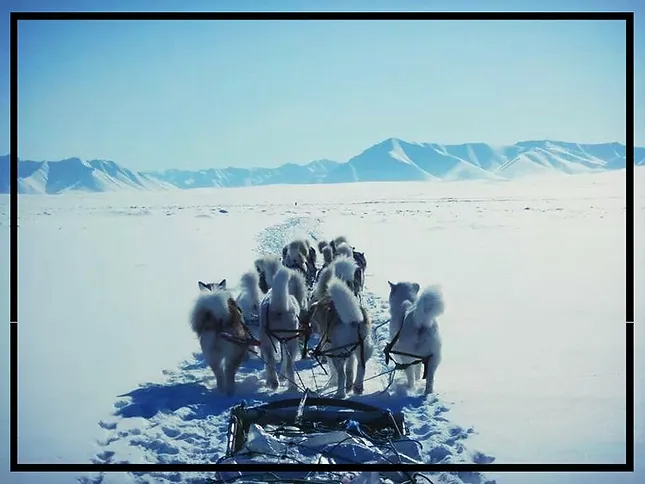
A rare working dog breed, the Seppala Siberian Sleddog is developed for the purpose of pulling a sled in cold country. It is a moderate-sized dog averaging 18 to 23 kg (40 to 50 pounds) weight and 56 to 58 cm (22 or 23 inches) height. Colors and markings are considered of little importance; eyes may be brown, blue or any combination of the two colors. Seppalas are active and energetic but very docile and trainable.
Seppalas show a primitive canine type, never having been bred or selected for conformation or the show ring. The breed shares its ancestral base with the Siberian Husky and for half a century shared the same registry with that breed, but was bred always exclusively as a working sleddog breed in its own right and kept apart from show bloodlines. In the late 1990s, it was recognized by Canadian agricultural authorities as a new “evolving breed” and in 2002 a similar separate breed initiative was started in the USA.
Seppalas of today differ markedly from many other Siberian Husky bloodlines in physical appearance, being in general less flashily marked, longer in leg and body length, and lighter in weight and physical build than most Siberian Husky show dog lines. Pure-strain Seppalas have dense, smooth coats of medium length with an undercoat nearly as long as the guard hairs. Their ears are taller, set close together and strongly erect, the "stop" of the head less well-defined than that of Siberian Huskies. The tail is held high in a sickle curve over the back when alert, never "snapped" flat to the back or curling down the flank.
Many Seppalas are pure white or buff and white. Others are very dark, black, or charcoal grey with dark faces and white only on the feet and tail tip. There are many varied shades of grey, brownish grey, and blue-grey. “Sable” reds with black-tipped guard hairs and black noses occur, but the liver-nosed “copper” phase seen in other lines of Siberian Huskies is unknown in pure Seppalas. Agouti "wild type" coloration and piebald spotting are common.
Seppalas are known for their extremely smooth and well-coordinated gait and for the consistency and strength with which they pull in harness. Although they appear to the inexperienced eye to be rather small and lightly built for sled dogs, actually they are far more efficient pullers than some larger northern breeds. They are capable racing sled dogs, particularly in mid-distance events, although perhaps not as speedy as world-class Alaskan huskies or pointer-crossed hybrids.
Like other northern breeds, they shed their coats hugely once or twice a year, cannot safely be allowed to run free off leash, and love to hunt small game. They are generally robust and healthy, living twelve to sixteen years, usually working well in harness up to ten or eleven years of age. Health issues for the breed are those common to all northern breeds, such as allergies, cancer and eye problems. They are highly efficient in their use of food, eating relatively little but requiring very high-quality nutrition that is rich in animal protein, animal fat, and fish oil.
The defining characteristics of the breed are its natural, primitive appearance, its highly developed work ethic, and its affectionate, cooperative, and highly bonded nature. They tend to be more trainable than other sled dogs and to be more highly bonded to their owners. The Seppala Siberian Sled dog disposition is active, merry, and often quite inquisitive, although sometimes showing great reserve with strangers. A stable and serious temperament, neither nervous nor aggressive, is characteristic. Natural, innate sled dog mentality is a primary characteristic of Seppala dogs. Their nature is highly cooperative. They show great seriousness in their work in harness
Back to top of page